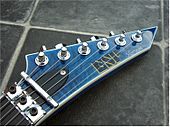Saddle (string instrument)


The saddle ( English nut ) is at plucked and bowed instruments a narrow piece of material at the transition between the peg or top plate is mounted and the neck of the instruments. It can either be inserted across the fingerboard or embedded in it. The purpose of the saddle is to safely guide the strings on the fingerboard. This is achieved by matching notches worked into the saddle, through which the strings run and which prevent the strings from sliding out of position across the fingerboard. The saddle also affects the string position of the instrument.
In English, saddle does not refer to the saddle on guitars, but a support on the bridge .
Manufacturing: material and orientation
Commonly used materials for instrument saddles are relatively hard materials such as bone (mostly from cattle ), graphite , various plastics , ebony and occasionally brass . The hardness of the material used affects the sound of the instrument. The harder the material of the saddle, the higher the pitch of the unfinished, "empty" strings . However, the influence of the saddle on the sound of strings that are not fingered is not always desirable. In order to match the sound of "open strings" with the strings that are being fretted, some instruments equipped with frets have an additional fret attached directly to the saddle on the fingerboard, on which the strings rest - the so-called " zero fret ".
The accuracy of fit of the saddle notches in width and depth is important for an optimal sound of stringed instruments. If the notches are too wide, the strings have too much play, which makes precise sound transmission difficult. If the saddle notches are too narrow, they pinch the strings, which hinders or even makes it impossible to tune the instrument accurately. Saddle notches that are too shallow lead to a high position of the strings, which makes it difficult to grip the strings, while saddle notches that are too deep cause unwanted contact between the strings and the fingerboard or the first fret, which causes unwelcome background noises when playing the instrument ("snarling"). Instrument makers therefore use special tools, the saddle files, to produce the saddle notches precisely and accurately .
So that the strings run to the pegs or tuning machines with sufficient pressure on the saddle notches, the peg box or headstock of most stringed instruments is angled backwards. This is particularly pronounced with kink- necked lutes whose pegbox is approximately at right angles to the neck . For electric guitars and basses non-angled headstock and arranged in a series tuners it is common for the pressure of the strings on the saddle by using a metal, screwed to the head plate Saitenniederhalter (English: String trees ) to increase.
Special forms of instrument saddles
A special form of saddle is used on some electric guitars with a vibrato lever (for example the Floyd Rose system): Here the metal saddle carries screws and clamping devices that fix each string in its position (clamp saddle) . This prevents the instrument from being detuned when tightening or loosening the string tension using vibrato. Another special form that is also used in electric guitars with a tremolo arm is the roller saddle . Here the strings run over individual movable rollers instead of through saddle notches, which is also intended to prevent the instrument from being detuned when the tremolo is used. The somewhat more inaccurate contact surface of the strings caused by the cylindrical shape of the rollers can lead to a reduction in the decay time of the played strings with roller saddles.
See also
literature
- Paul Day, Heinz Rebellius (Eds.), André Waldenmaier: E-Guitars - Everything about construction and history . Chapter: Der Sattel, p. 45 ff. GC Carstensen Verlag, Munich 2001. ISBN 3-910098-20-7
- Franz Jahnel: The guitar and its construction - technology of guitar, lute, mandolin, sister, tanbur and strings. Erwin Bochinsky publishing house, Frankfurt am Main 1963, 7th edition 1999. ISBN 3-923639-09-0
- Alexander Schmitz: The guitar . Ellert & Richter Verlag, 1988
